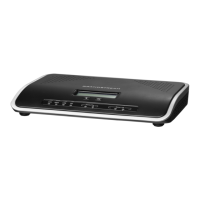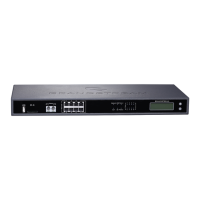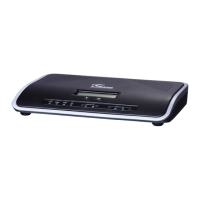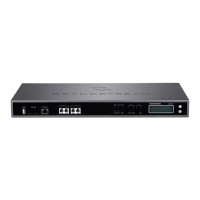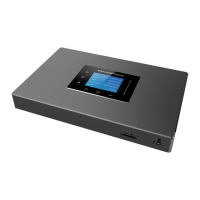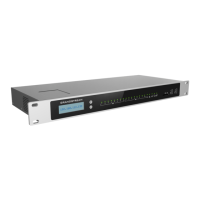GXE502X User Manual 11/2/2009
57
SIPDID: This variable will be used in the conditional expression to specify a particular DID associated
with a SIP trunk connected to the GXE. We can use it in combination with the time and date conditions
to route incoming calls to a particular IVR, extension, conference, etc that we choose.
Call Paths
Each digit map consists of up to 5 different call paths. Call paths are the routes that we choose to direct a call;
they can be either outgoing or incoming. Each call path is also composed of 3 different fields: Digit
Manipulation, Option and Value.
The idea behind the call paths is to have fallback routes in case one of them is blocked or not available.
For example one call path could be routing the call through a SIP trunk, but maybe the server of the service
provider is down, in that case if there is a second call path configured, let’s say a PSTN trunk, the GXE will try
to make the call through it. Each call path can be configured completely different from the other ones and it is
left at the absolute will of the administrator how to configure them.
Digit Manipulation
Digit Manipulation will allow the administrator to manipulate the digits being received by the call routing
profile as he might please. This can be done in 3 ways: addition, deletion and replacement.
The rules are the following:
1. (I:NN) is to add number NN.
2. (D:XXX) is to delete any 3 digits mapped in the position, XXX.
3. (M:XXX:NN) is to replace any 3 digits in the position where XXX is with digits NN.
In other words (I:) is used to INSERT any digits in the position that the administrator wants.
This is typically done at the beginning of the number dialed but we can insert numbers in any position of the
string dialed. For example:
o (I:99)XXXXXXXX will insert the digits 99 in front of an 8 digit dialed string, so the numbers
dialed out will be like: 99XXXXXXXX.
o We could also put them in the middle or at the end: XXXX(I:99)XXXX or XXXXXXXX(I:99)
and we would get XXXX99XXXX and XXXXXXXX99 respectively.
(D:) is used to DELETE any digits in the position that the administrator wants. Again this is typically done at
the beginning of the number dialed but we can insert numbers in any position of the string dialed. For example:
o (D:X)XXXXXXXX will delete the first number dialed from the string
o (D:XXX)XXXXXX will delete the first 3 numbers of the dialed string.
Just as in the previous example we can select to delete digits on any position in the string. This is very useful
when we want to force users to dial a certain prefix in order to gain access to a particular trunk.
(M:XXX:NN) is used to replace any 3 digits in the position where XXX is with the digits NN. This is called
MANIPULATE. Some users might find it useful in order to create certain routes. For example:
o For (D:XX)(I:17951)XXXXXXXX(M:XXXX:4321), if dialed number is 99075526031234, then the
